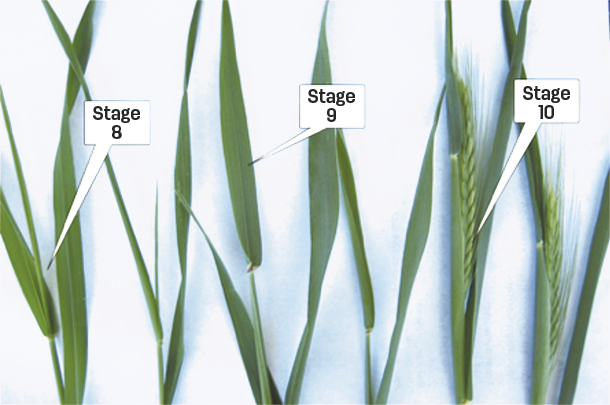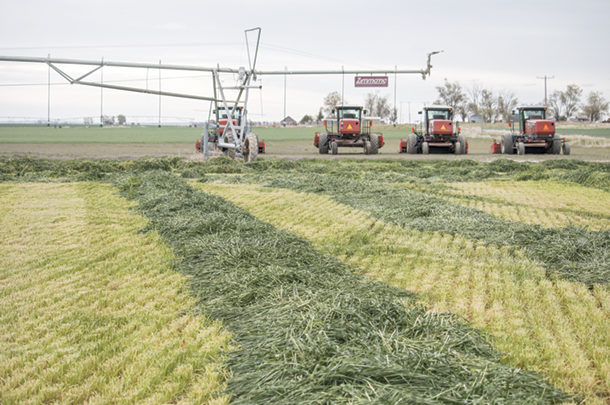At the time of this writing, it is too early to know how this winter is going to be, but in different parts of the country, there are reasons for concern about forage stands being damaged over the winter. The long and short of it is: There will be a need for forage this spring.
I encourage you to take some time as spring approaches to plan for some “what if” scenarios for this spring. Think about when you want to harvest your small-grain forages and what you will plant next. What will you do if weather delays your harvest significantly? Thinking about these things now can save us from panicking about them when they happen. As you will see in the remainder of this article, my bias is toward harvesting high-quality forage. If harvesting maximum tonnage is your primary goal, that is fine. There are no right or wrong answers when it comes to forages. I will also be assuming that the forage will be mechanically harvested, but the principles can apply in grazing situations as well.
If you were fortunate enough to get some fall annuals planted, a big question this spring will be when to cut those forages. If your forage supply is short, it can be very tempting to let small grains grow for as long as possible to generate maximum tonnage. It is well documented that dry matter tonnage can increase by 50%, or in some cases even double, between flag leaf and soft-dough stage in small grains. Getting 5 tons per acre at the soft-dough stage instead of 2.5 tons at the flag-leaf stage can seem like a “no-brainer.” However, another thing that is well documented is the forage quality decline that happens from flag leaf to soft dough.

The range in quality between small-grain forage harvested at flag-leaf stage and soft dough is much more dramatic than we see with grass or legumes. If harvested at flag leaf or earlier, small-grain forage is some of the highest-quality forage you can grow. On the other end of the scale, forage harvested at soft dough can be thought of as just slightly better than “straw with some grain in it.”
Depending on what type of livestock you are feeding, you may be able to get by with subpar forage quality. But there is still another topic to address for harvesting grains at the soft-dough stage: In the arid West where I live, we routinely make grain hay at soft-dough stage. For anyone trying to make dry hay in the humid eastern part of the country, soft-dough-stage small grains can be extremely hard to get dry. The heads dry slow, and the windrows are huge and hard to move. Making silage can also be challenging because the material doesn’t pack well due to the hollow stems of the grain at that time. Wrapped baleage might be a better choice, if that is possible. If you decide to take small-grain forage all the way to soft dough, be sure you are prepared to put that forage up.
When put in the perspective of the whole harvest season, fall-planted small-grain forage will be the first thing you harvest – slightly before grass and alfalfa are ready for boot-stage harvest. If Mother Nature throws a curve ball and you have small grains, grass stands and alfalfa stands ready to cut at the same time, what should your priority be? I would argue that you cut the grains first, not only because they are losing quality rapidly, but also you need to get them off to start the next crop in your rotation. My second priority would be grass because it can lose quality faster than alfalfa. And third, cut the alfalfa. It might be in bloom by the time you get to it, but the protein will still be high, and it was already going to have the lowest fiber digestibility of these three.
In many cases, sacrificing some tonnage on your small grains can allow you to get a subsequent crop planted in a timely fashion, and you can make up tonnage with that crop. As a guide, small grains will take three to four weeks to get from flag leaf to soft-dough stage. If your plan is to follow small grains with corn, you will have to plant a significantly shorter-day corn after a soft-dough harvest, and you may lose any advantage in small-grain yield due to having to grow shorter-season corn.
Some readers will be planting small grains this spring as well. It is worth mentioning that the same dynamics between quality and yield must be managed in spring-planted grains as well. In general, these crops are growing in a bit warmer weather, and we can’t quite match the tonnage of fall-planted grains. Also, if it turns hot these crops will mature faster than they should, causing a loss in yield and quality. Planting as early as you can get in the fields gives spring-planted grains the best chance of success.
Small-grain forages are an excellent addition to many farm plans. They play a key role in providing some early forage that can be amazing feed. Your best opportunity to capture energy in forage (in the form of digestible fiber) is with small grains like triticale harvested before it heads. Small grains also keep soil covered over the winter and prepare the soil for the crops that follow them. But with unpredictable spring weather, it is easy for these crops to get more mature than we like. Knowing what to expect and having contingency plans in case you miss your desired harvest window can relieve significant amounts of stress in the spring. After an extremely challenging 2019, we can all do with a little less stress in 2020. ![]()
PHOTO 1: Small grains harvested in spring are a great opportunity to capture energy in forage if it’s harvested at the right time. Photo by Lynn Jaynes.
PHOTO 2: Maturity stages of small grains, using triticale as an example. At stage 8, the flag leaf is starting to emerge. Stage 9 occurs when the flag leaf is done growing and its collar forms. The end of boot stage is shown at stage 10 with the head emerging from the boot. Maximum forage quality occurs at stage 9. By the time you see heads emerging, the best forage quality is passed. Photo courtesy of Cornell University Cooperative Extension, Agronomy Fact Sheet 56.

-
Chad Hale
- Research and Acquisitions
- Manager
- Western Forage Resource
- Email Chad Hale










